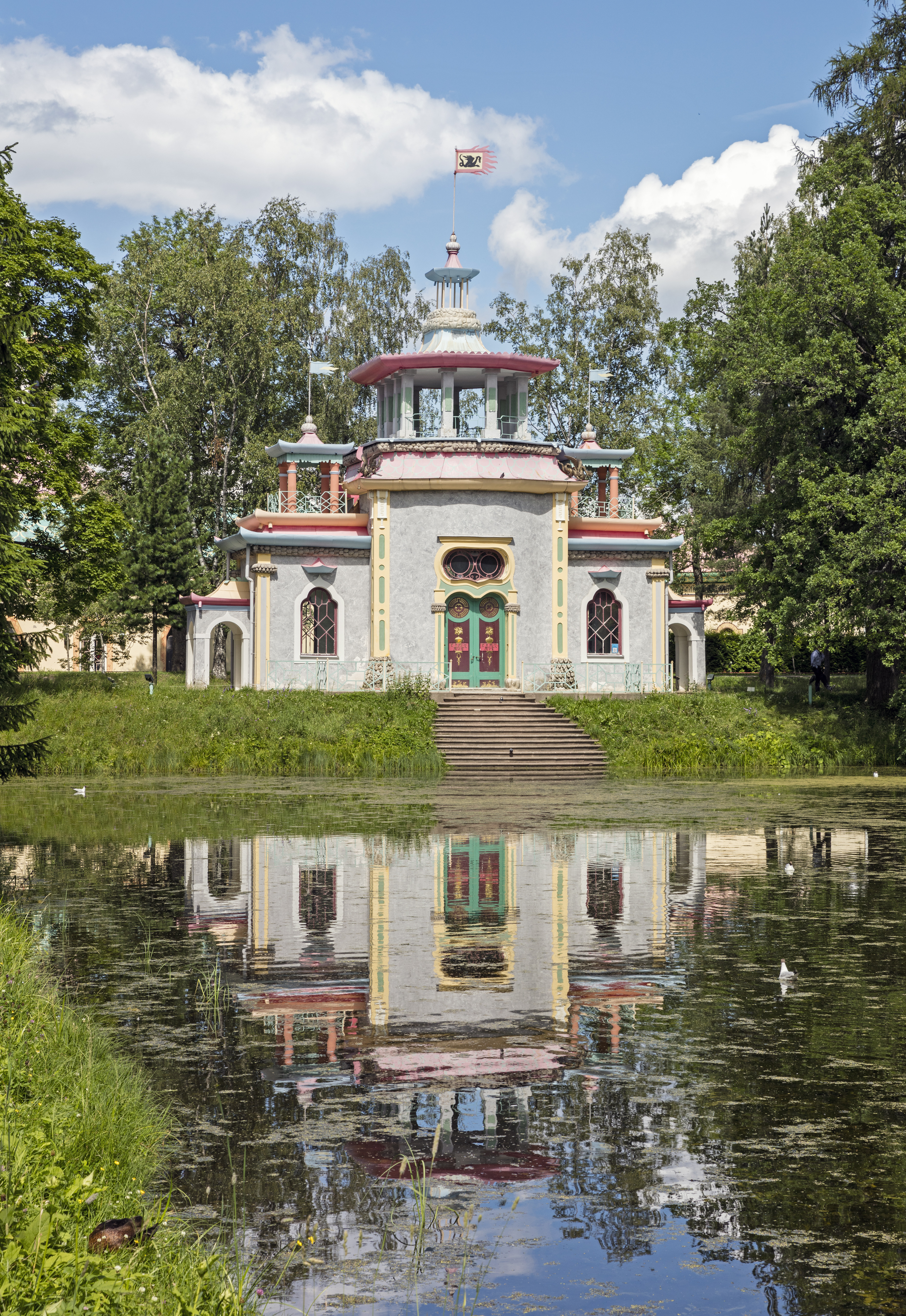Creaking Pagoda on:
[Wikipedia]
[Google]
[Amazon]
 The Creaking Pagoda (Скрипучая беседка), also known as the Chinese Summer House (Китайская беседка), is a small
The Creaking Pagoda (Скрипучая беседка), also known as the Chinese Summer House (Китайская беседка), is a small
File:Sankt-Peterburg_oldfoto_13715.jpg, alt=слева, In 1912
File:Magic Sankt Petersburg - Puschkin - Katharina's Palace Garden 2.jpg, In 2004, before the most recent restoration was completed
File:Chinese Summer House, interior 04.JPG, One of the doors, from the inside, in 2011
File:Пушкин, Екатерининский парк, Китайская беседка.jpg, In 2014
File:Скрипучая беседка. 7.JPG, Dragons at the corners of the roof
 The Creaking Pagoda (Скрипучая беседка), also known as the Chinese Summer House (Китайская беседка), is a small
The Creaking Pagoda (Скрипучая беседка), also known as the Chinese Summer House (Китайская беседка), is a small summer house
A summer house or summerhouse has traditionally referred to a building or shelter used for relaxation in warm weather. This would often take the form of a small, roofed building on the grounds of a larger one, but could also be built in a garden ...
located between two ponds in Tsarskoe Selo
Tsarskoye Selo ( rus, Ца́рское Село́, p=ˈtsarskəɪ sʲɪˈlo, a=Ru_Tsarskoye_Selo.ogg, "Tsar's Village") was the town containing a former residence of the Russian imperial family and visiting nobility, located south from the cen ...
, Russia
Russia (, , ), or the Russian Federation, is a List of transcontinental countries, transcontinental country spanning Eastern Europe and North Asia, Northern Asia. It is the List of countries and dependencies by area, largest country in the ...
. It stands in on the boundary separating the Catherine Park
The Catherine Park (russian: Екатерининский парк) is the large landscaped area to the south of the Catherine Palace, located in the town of Tsarskoye Selo (Pushkin), 25 km south-east of St. Petersburg, Russia.
The park has t ...
of the baroque
The Baroque (, ; ) is a style of architecture, music, dance, painting, sculpture, poetry, and other arts that flourished in Europe from the early 17th century until the 1750s. In the territories of the Spanish and Portuguese empires including t ...
Catherine Palace
The Catherine Palace (russian: Екатерининский дворец, ) is a Rococo palace in Tsarskoye Selo (Pushkin), 30 km south of St. Petersburg, Russia. It was the summer residence of the Russian tsars. The Palace is part of the ...
and the New Garden of the Alexander Park of the neoclassical Alexander Palace
The Alexander Palace (russian: Александровский дворец, ''Alexandrovskiy dvorets'') is a former imperial residence near the town of Tsarskoye Selo in Russia, on a plateau about south of Saint Petersburg. The Palace was c ...
.
The pagoda
A pagoda is an Asian tiered tower with multiple eaves common to Nepal, India, China, Japan, Korea, Myanmar, Vietnam, and other parts of Asia. Most pagodas were built to have a religious function, most often Buddhist but sometimes Taoist, ...
is a long but narrow folly
In architecture, a folly is a building constructed primarily for decoration, but suggesting through its appearance some other purpose, or of such extravagant appearance that it transcends the range of usual garden buildings.
Eighteenth-cent ...
that resulted from the 18th-century taste for Chinoiserie
(, ; loanword from French ''wikt:chinoiserie#French, chinoiserie'', from ''wikt:chinois#French, chinois'', "Chinese"; ) is the European interpretation and imitation of China, Chinese and other East Asia, East Asian artistic traditions, especial ...
, reflected in other buildings constructed for Catherine the Great
, en, Catherine Alexeievna Romanova, link=yes
, house =
, father = Christian August, Prince of Anhalt-Zerbst
, mother = Joanna Elisabeth of Holstein-Gottorp
, birth_date =
, birth_name = Princess Sophie of Anhal ...
. It was constructed near the Chinese Village
The Chinese Village in the Alexander Park of Tsarskoye Selo, Russia was Catherine the Great's attempt to follow the 18th-century fashion for the Chinoiserie.
Probably inspired by a similar project in Drottningholm, Catherine ordered Antonio ...
in 1778 to 1786, designed by Georg von Veldten
Georg may refer to:
* Georg (film), ''Georg'' (film), 1997
*Georg (musical), Estonian musical
* Georg (given name)
* Georg (surname)
* , a Kriegsmarine coastal tanker
See also
* George (disambiguation)
{{disambiguation ...
, also known as Yury Velten, possibly with input from Antonio Rinaldi. Construction lasted from 1778 to 1786. The walls are decorated with figures of dragon
A dragon is a reptilian legendary creature that appears in the folklore of many cultures worldwide. Beliefs about dragons vary considerably through regions, but dragons in western cultures since the High Middle Ages have often been depicted as ...
s and other stylized Chinese motifs. are gilded wooden sculptures of dragons at the corners of the roof, carrying bells in their mouths, and steps from the main entrance lead down to the water. The structure fell into disrepair in the 19th and 20th centuries, and was damaged in the Second World War, but it was restored from 1954 to 1956. Further restoration work in the 1990s, including a new roof, before the 200th anniversary of Tsarskoe Selo. Chinese characters for "Welcome" were added on the main door.
The name of the structure refers to a characteristic sound produced by a metal weathervane, shaped like a banner, on the top of the structure which creaks when it is turned by the wind.
References
Buildings and structures completed in 1786 Buildings and structures in Pushkin Folly buildings in Russia Chinoiserie Cultural heritage monuments of federal significance in Saint Petersburg {{Russia-struct-stub